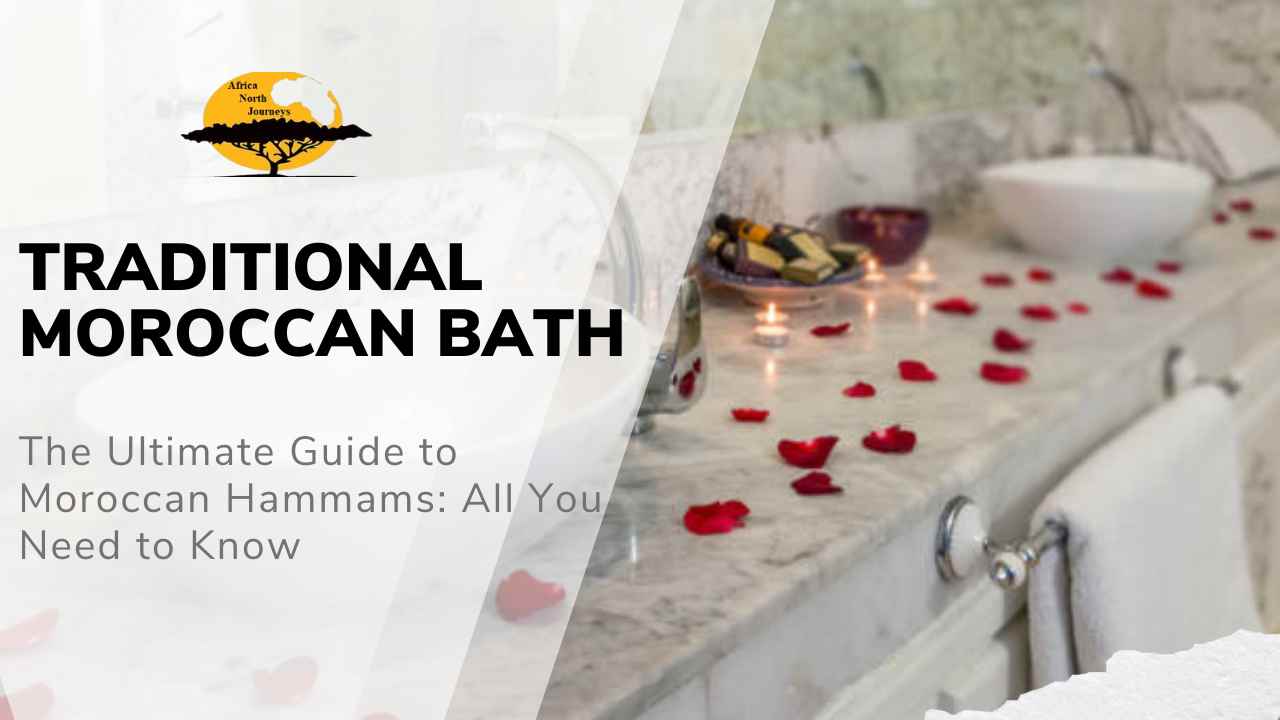Moroccan Bath

Africa North Journeys
Moroccan hammams, or traditional baths, are a cornerstone of Moroccan culture and social life. They offer a unique and rejuvenating experience that combines elements of relaxation, hygiene, and social interaction. This comprehensive guide will provide you with all the information you need to fully understand and enjoy a Moroccan hammam, from its historical and cultural significance to the step-by-step process and tips for first-timers.
The concept of the hammam dates back to ancient Roman times, where public baths were an essential part of daily life. When the Romans expanded into North Africa, they brought their bathing traditions with them. Over time, these baths evolved and integrated with Islamic culture, resulting in the hammams we see today.
Hammams are more than just places for physical cleansing; they play a vital role in the social fabric of Moroccan society. They are communal spaces where people gather to relax, socialize, and maintain personal hygiene. In many towns and cities, the local hammam is a central hub of community life, particularly for women, who may use the time to catch up with friends and relatives.
Hammams also hold religious significance in Islam. Cleanliness is an essential aspect of Islamic practice, and hammams provide a place for Muslims to perform their ablutions before prayers. Additionally, hammams are often used in preparation for significant life events such as weddings and childbirth, making them a crucial part of Moroccan cultural and religious traditions.
Moroccan Bath
There are two main types of hammams in Morocco: public hammams and private (or luxury) hammams.
Public Hammams: These are the traditional and most common type of hammam. They are affordable and cater to the local population. Public hammams are typically separated by gender, with specific times allocated for men and women.
Private/Luxury Hammams: These are often found in high-end hotels and resorts. They offer a more luxurious and private experience, usually at a higher price. These hammams may also offer additional services such as massages, facials, and other spa treatments.
A typical hammam consists of three main rooms, each with varying temperatures:
The Hot Room (Harara): This is the first room you enter, designed to open your pores and start the sweating process. It’s similar to a steam room and is usually the hottest of the three rooms.
The Warm Room (Tepidarium): The second room is moderately warm and is where most of the washing and scrubbing takes place. The temperature is more comfortable, allowing for extended stays.
The Cool Room (Frigidarium): The final room is cooler and used for relaxation after the intense heat and scrubbing. It allows your body to slowly adjust back to a normal temperature.
Understanding the etiquette is crucial for a positive hammam experience. Here are some key points to keep in mind:
Dress Code: Modesty is important. Women typically wear bikini bottoms or underwear, while men usually wear swim trunks. Some public hammams may provide a small towel or sarong, known as a “fouta,” to cover up.
Respect the Space: Hammams are communal spaces, so maintaining a respectful and quiet demeanor is appreciated. Avoid loud conversations and respect others’ privacy.
Cleanliness: Make sure to shower before entering the hammam to keep the water clean for everyone.
Hydration: Drink plenty of water before and after your hammam visit to stay hydrated.
Before heading to the hammam, gather all the necessary items. Here’s what you’ll need:
Upon arrival, you’ll typically pay an entrance fee. In public hammams, this fee is quite affordable, usually ranging from 10-50 MAD. You’ll be given a bucket and a small stool to sit on.
Start your journey in the hot room. The intense heat helps to open your pores and starts the detoxification process. Spend around 10-15 minutes here, allowing your body to adjust to the temperature and begin sweating.
Move to the warm room, where you’ll spend most of your time. Here’s a step-by-step guide to the process:
Rinse Off: Use the buckets provided to pour warm water over yourself, rinsing off any initial sweat and dirt.
Apply Black Soap: Rub the traditional black soap all over your body. This olive-based soap is known for its moisturizing and exfoliating properties.
Scrubbing: After letting the soap sit for a few minutes, use the exfoliating glove (kessa) to scrub your skin. This part can be quite vigorous, removing dead skin cells and leaving your skin feeling smooth and rejuvenated. Don’t be alarmed if you see rolls of dead skin coming off—this is a sign of an effective scrub.
Rinse Again: Thoroughly rinse off the soap and dead skin with warm water.
Many people choose to wash their hair in the warm room. Use your shampoo and conditioner to clean your hair, ensuring that you rinse thoroughly.
After the scrubbing and washing, move to the cool room to relax. This room allows your body to slowly return to its normal temperature. Spend as much time as you need here, enjoying the peaceful environment.
Once you’re done relaxing, give yourself a final rinse to ensure all soap and dead skin are washed away. Dry off with your towel or robe, and brush your hair to detangle any knots.
Moroccan Bath
Regular visits to the hammam offer numerous health and wellness benefits:
The combination of heat, black soap, and exfoliation helps to deeply cleanse and rejuvenate the skin. The scrubbing process removes dead skin cells, unclogs pores, and leaves the skin feeling soft and smooth.
Sweating in the hot room aids in detoxification by flushing out toxins from the body. This process can improve overall health and vitality.
The warm environment and soothing atmosphere of the hammam provide a perfect setting for relaxation. The heat and steam help to relax muscles and alleviate tension, promoting mental and physical well-being.
The heat and scrubbing stimulate blood circulation, which can improve overall cardiovascular health and boost the immune system.
For your first visit, consider choosing a private or luxury hammam if you prefer a more comfortable and guided experience. These establishments often provide more personalized service and can help you navigate the process.
If possible, go to the hammam with a local friend or guide. They can help you understand the customs and ensure you have a positive experience.
Take your time to enjoy each step of the process. The hammam experience is meant to be relaxing and rejuvenating, so there’s no need to rush.
Drink plenty of water before and after your hammam visit to stay hydrated, especially due to the sweating involved.
The scrubbing can be intense, but it’s an essential part of the experience. If you find it too rough, let the attendant know, and they can adjust the pressure.
The hammam is a social space. Don’t be afraid to engage in conversation with others if it feels appropriate. It’s a great way to connect with locals and learn more about Moroccan culture.
Moroccan Bath
If you’re looking for some of the best hammams in Morocco, here are a few notable options:
Located in the heart of Marrakech, Hammam Mouassine is one of the oldest and most famous hammams in the city. It offers an authentic experience with beautiful traditional architecture.
A popular choice for tourists, Les Bains de Marrakech offers a luxurious hammam experience with a range of additional spa treatments. It’s a great place for those looking for comfort and relaxation.
Situated in the historic city of Fez, this hammam is known for its stunning tile work and authentic atmosphere. It’s a perfect spot for those looking to immerse themselves in Moroccan culture.
Located in the Atlas Mountains, this hammam is known for its natural hot springs. It offers a unique and therapeutic experience, combining the benefits of a traditional hammam with the healing properties of natural mineral water.
Visiting a Moroccan bath (Hammam) is a must-do experience for any traveler looking to immerse themselves in the local culture. It offers a unique blend of relaxation, social interaction, and health benefits that are deeply rooted in Moroccan traditions. Whether you choose a public hammam for an authentic experience or a private hammam for a more luxurious one, understanding the customs and following the etiquette will ensure you have a memorable and enjoyable visit. So, prepare your towel, embrace the tradition, and get ready to rejuvenate your body and soul in a Moroccan Bath (Hammam).
Casablanca Tours:
Tangier Tours:

